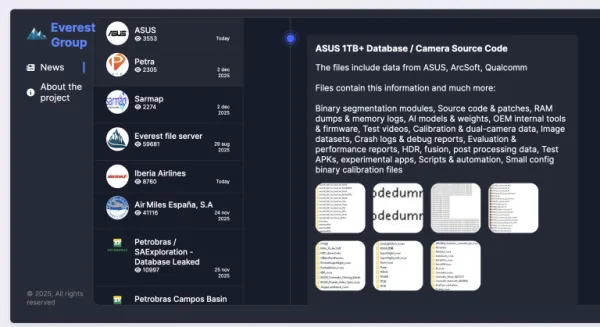Who's Been Getting Hacked? A Look at Major Cyberattacks in Late 2025

As October 2025 draws to a close, the cybersecurity landscape continues to be battered by an unrelenting wave of sophisticated attacks. From nation-state espionage campaigns to massive ransomware operations, organizations worldwide are facing unprecedented threats. Here's a comprehensive look at who's been targeted and what's at stake.
The F5 Breach: A Nation-State Wake-Up Call
Perhaps the most alarming incident of recent months involved Seattle-based cybersecurity giant F5. In mid-October, the company disclosed that a sophisticated nation-state threat actor had maintained long-term access to its systems, stealing portions of BIG-IP source code and information about undisclosed vulnerabilities.

The breach, which F5 discovered in August but delayed disclosing at the request of the U.S. Department of Justice, represents a significant escalation in supply chain attacks. The attackers, reportedly linked to China-backed group UNC5221 using the BRICKSTORM malware, maintained access for at least 12 months. The stolen source code gives adversaries a technical advantage to develop zero-day exploits targeting F5's widely-used enterprise products.
The U.S. Cybersecurity and Infrastructure Security Agency (CISA) immediately issued Emergency Directive ED 26-01, ordering federal agencies to inventory all F5 products, remove management interfaces from public internet access, and apply security updates by October 22. F5's stock plummeted 10% following the disclosure, marking its worst day since 2022.
Ransomware Rampage: Scattered Spider and Beyond
The notorious hacking collective Scattered Spider (also operating as Scattered Lapsus$ Hunters, combining members from Scattered Spider, ShinyHunters, and Lapsus$ groups) has been on a tear throughout 2025, with victims spanning multiple continents and industries.
Qantas Airways
In October, Scattered Spider leaked personal information of 5.7 million Qantas customers after a ransom deadline expired. The data breach, stemming from a compromise of a Salesforce-hosted customer service platform, exposed names, emails, phone numbers, addresses, dates of birth, and frequent flyer details. The hackers claimed to have stolen data from 39 companies using Salesforce systems, affecting over one billion records globally.

Major Retailers Hit Hard
During Easter weekend in April, British retailer Marks & Spencer (M&S) suffered a devastating cyberattack attributed to Scattered Spider. Attackers used social engineering to bypass contractor defenses, disabling online shopping including click-and-collect and fashion sales for six weeks. The incident cost M&S an estimated £300 million in losses. The same group also targeted Co-op and other UK retailers in coordinated campaigns.

European Aviation Under Siege
On September 19, a ransomware attack on Collins Aerospace's passenger processing system MUSE disrupted operations at several major European airports, including Heathrow, Brussels, and Berlin. The supply chain attack spread rapidly across borders, causing flight delays and long queues as airlines struggled with compromised check-in and baggage systems.

Healthcare in the Crosshairs
The healthcare sector continues to be a prime target for cybercriminals, with patient data and operational disruptions offering lucrative ransom opportunities.
PIH Health Hospitals in California suffered a ransomware attack affecting more than 3 million patients, temporarily preventing them from accessing healthcare until systems came back online. Yale New Haven Health System experienced a breach in April affecting 5.5 million patients after threat actors infiltrated their systems.
The Medusa ransomware gang targeted HCRG Care Group, stealing 2.275 TB of patient data, while the Radiant ransomware group shocked the cybersecurity community by infiltrating Kido International nurseries, stealing sensitive data on approximately 8,000 children including photographs, names, addresses, and dates of birth.

Corporate Giants Under Attack
Technology and Finance
Google confirmed a data breach in August stemming from a compromised Salesforce-hosted corporate database. While consumer accounts weren't directly affected, the exposed business data has been weaponized in subsequent phishing attacks.

Allianz Life saw over a million customers at risk after an unauthorized actor accessed a third-party CRM system used by the insurance giant, compromising data on the "majority" of customers.
TransUnion and Air France-KLM also fell victim to breaches traced to the ShinyHunters hacking group, which exploited third-party platforms like Salesforce and Drift using social engineering techniques.
Manufacturing and Defense
North Korean hackers, as part of Operation Dream Job, have been targeting European defense companies involved in the UAV (drone) sector since late March. The campaign aims to steal proprietary information and manufacturing know-how using malware families like ScoringMathTea and MISTPEN, likely to advance North Korea's drone program.

Jaguar Land Rover and automotive giant Stellantis both confirmed data breaches affecting customer information. Stellantis's incident on September 24 stemmed from a compromise of their Salesforce instance through a third-party connected app.
Government and Infrastructure Attacks
United States
The U.S. Department of Defense suffered a significant breach when hundreds of compromised credentials belonging to DoD personnel appeared for sale on the dark web. Attackers bypassed multi-factor authentication using stolen session cookies, potentially giving them access to classified military systems.
In April, hackers spied on emails of roughly 103 U.S. bank regulators at the Office of the Comptroller of the Currency for over a year, accessing approximately 150,000 emails containing highly sensitive financial institution data.
TeleMessage, a compliance messaging app used by U.S. government officials including those from FEMA and CBP, was compromised in May, exposing metadata from over 60 accounts.
State-Sponsored Activity
China's Ministry of State Security claimed in October that the NSA used 42 cyber tools in a multi-stage attack on Beijing time systems, employing tactics like forging digital certificates and using high-strength encryption to erase attack traces.
A coordinated spear-phishing campaign dubbed PhantomCaptcha on October 8 targeted Ukraine's war relief efforts, hitting organizations including the International Red Cross, Norwegian Refugee Council, UNICEF Ukraine office, and Ukrainian regional government administrations. The attackers impersonated the Ukrainian President's Office to deliver remote access trojans.
Rhode Island Cyberattack
A major cyberattack exposed personal and bank information of hundreds of thousands of Rhode Island residents, with an international cybercriminal group thought to be responsible.
Airlines and Travel
Vietnam Airlines contacted customers on October 14 to inform them that hackers had uploaded 23 million records to a forum, including airline customer data spanning from November 2020 to June 2025. The breach originated from a third-party platform.
Supply Chain and Third-Party Risks
A recurring theme throughout 2025 has been the exploitation of third-party vendors and supply chain partners. The Drift supply chain attack impacted several major organizations including Palo Alto Networks, Zscaler, Google, Cloudflare, PagerDuty, Tenable, Qualys, and Dynatrace, exposing business contact details and sales records.

In March, Bank Sepah in Iran suffered one of the largest financial institution cyberattacks when the hacker collective "Codebreakers" stole 42 million customer records (approximately 12 TB of data), demanding a $42 million Bitcoin ransom.
Cryptocurrency Heists
North Korean hackers, specifically the Lazarus Group, stole approximately $1.5 billion in Ethereum from Dubai-based exchange ByBit in February, exploiting a vulnerability in third-party wallet software. It remains the largest cryptocurrency heist to date, with at least $160 million laundered within the first 48 hours.

The Evolving Threat Landscape
As we approach the end of 2025, several trends are clear:
1. Nation-State Activity Intensifying: Chinese, Russian, North Korean, and Iranian threat actors have dramatically increased operations, with some industries experiencing 200-300% surges in attacks compared to previous years.
2. Supply Chain Vulnerabilities: Third-party platforms like Salesforce, Drift, and other SaaS providers have become prime attack vectors, allowing hackers to cascade through multiple downstream entities.
3. AI Weaponization: Iran-linked actors have begun using generative AI tools to amplify leaked information and enhance social engineering campaigns.
4. Healthcare Targeting: Medical facilities continue to be lucrative targets due to valuable patient data and the critical nature of healthcare services.
5. Ransomware Evolution: Groups like LockBit re-emerged in 2025 with updated toolkits (LockBit 4.0), while survey data shows approximately 63% of organizations now decline to pay ransoms, up from 59% in 2024.
6. Record-Breaking DDoS: Cloudflare reported a DDoS attack peaking at 22.2 terabits per second and 10.6 billion packets per second, lasting 40 seconds—nearly double the previous record set earlier in September 2025.
The Bottom Line
The cyberattack frequency continues to climb dramatically. Weekly attacks per organization have more than doubled from 818 in Q2 2021 to 1,984 in the same period this year—a 58% increase in just two years. Small businesses are particularly vulnerable, with seven times more organizations reporting insufficient cyber resilience than in 2022.
As one cybersecurity expert noted about the F5 breach: "The adversary now possesses a technical advantage, allowing them to analyze source code and weaponize unpatched flaws far faster than any defender can reverse-engineer a patch."
With only 14% of organizations having adequate cybersecurity talent and developing nations hit hardest by skills gaps, the challenge ahead is clear: organizations must prioritize incident response readiness, strengthen supply chain security, and invest in AI-enhanced defensive capabilities to combat increasingly sophisticated threats.
The message for October 2025 is stark—no sector is immune, and the attackers are only getting more creative, persistent, and dangerous.
Note: This article is based on publicly disclosed incidents as of October 24, 2025. Many breaches go unreported or are discovered months after initial compromise.














